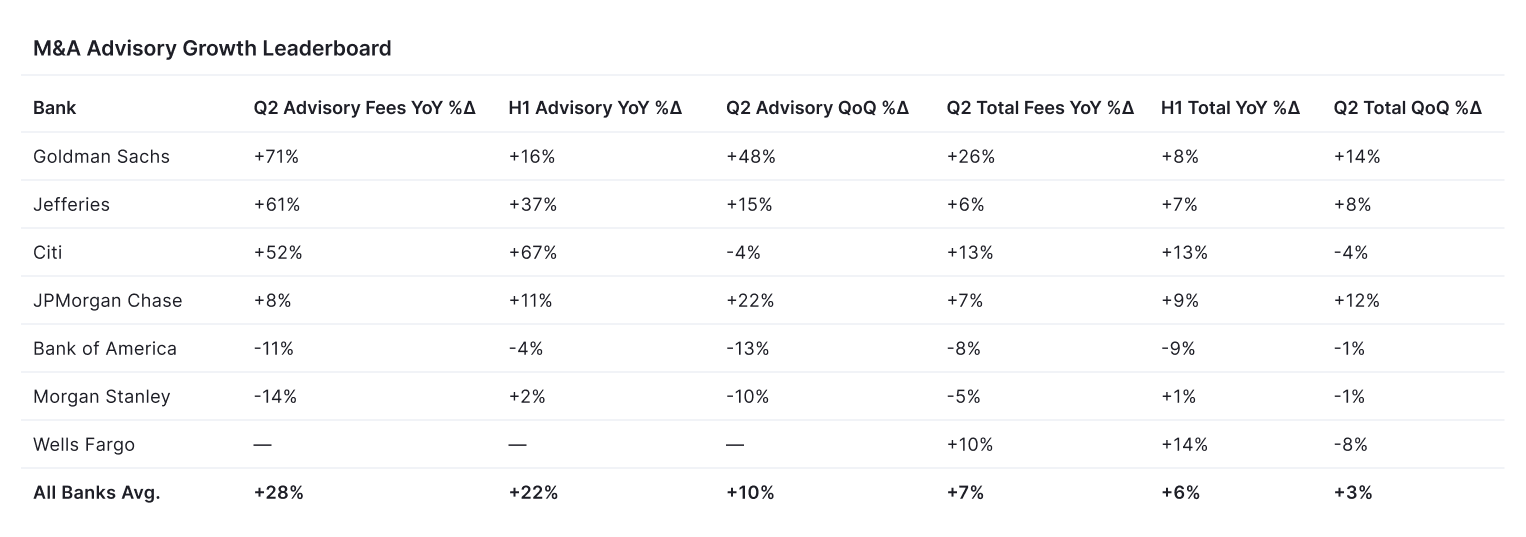Advisory fees at major US investment banks rose 28% on average year-over-year in the second quarter, up from 6% in the first, and total investment banking fees increased 7%.
Overall, four out of six investment banks that reported their advisory fees—JPMorgan, Goldman Sachs, Citigroup and Jefferies—reported positive YoY growth for the second quarter, while Bank of America and Morgan Stanley saw a drop of 11% and 14% respectively. Wells Fargo only reports total investment banking fees.
Raymond James, Piper Sandler and Houlihan Lokey have yet to report their second quarter earnings.
Even as quarter-over-quarter advisory growth averaged 10%, most major banks posted quarter-over-quarter declines in total fees (equity, debt and advisory), and half of those reporting advisory fees saw quarter-over-quarter declines—going against the historical trend of the second quarter outperforming the first.
While second-quarter performance improved relative to 2024, the underlying data points to uneven momentum across firms and quarters.

To stay up-to-date with the latest news and analysis on investment banking in the upper and middle markets—including our upcoming analysis on earnings for middle market banks—make sure to sign up for our newsletter The Investment Banker’s Brief and follow us on LinkedIn.
Overall, compared to the first half of last year, advisory fees in the first half of this year grew by 22% on average and total fees grew by 6%. Meanwhile, Bank of America saw negative year-over-year growth in the first half of this year for both fee categories.
Goldman Sachs and Citigroup led advisory growth in the second quarter, with year-over-year increases of 71% and 52%, respectively. In total fees, Goldman posted the highest YoY gain at 26%, followed by Citigroup at 13%.
For the first half of the year, Citigroup and Jefferies reported the strongest advisory growth, up 67% and 37%, respectively.
Quarter-over-quarter, Goldman recorded a 48% jump in advisory fees, followed by JPMorgan at 22%. In total fees, Goldman and JPMorgan again led with increases of 14% and 12%, respectively.
Despite record levels of volatility and uncertainty, major investment banks have benefited from a relatively strong stock market, a more active global market for M&A, and an increase in the size of mega-deals—trends that don’t always have the same material effects on the American middle market.
While M&A volumes increased in H1, deal count remained relatively flat and was down around 15% in the US.
Overall, “The US economy remained resilient in the quarter,” Dimon said. “The finalization of tax reform and potential deregulation are positive for the economic outlook. However, significant risks persist – including from tariffs and trade uncertainty, worsening geopolitical conditions, high fiscal deficits and elevated asset prices.”






